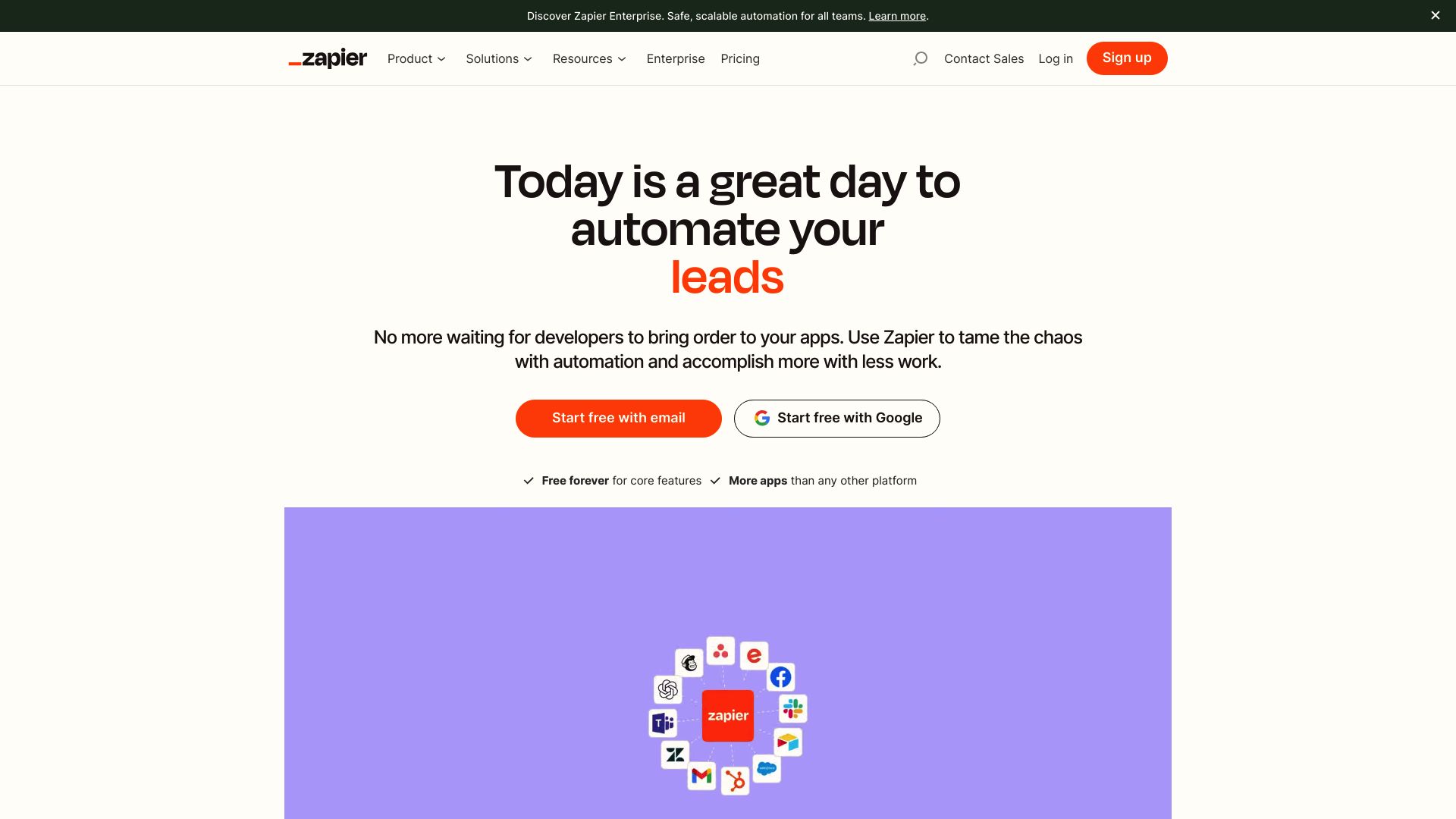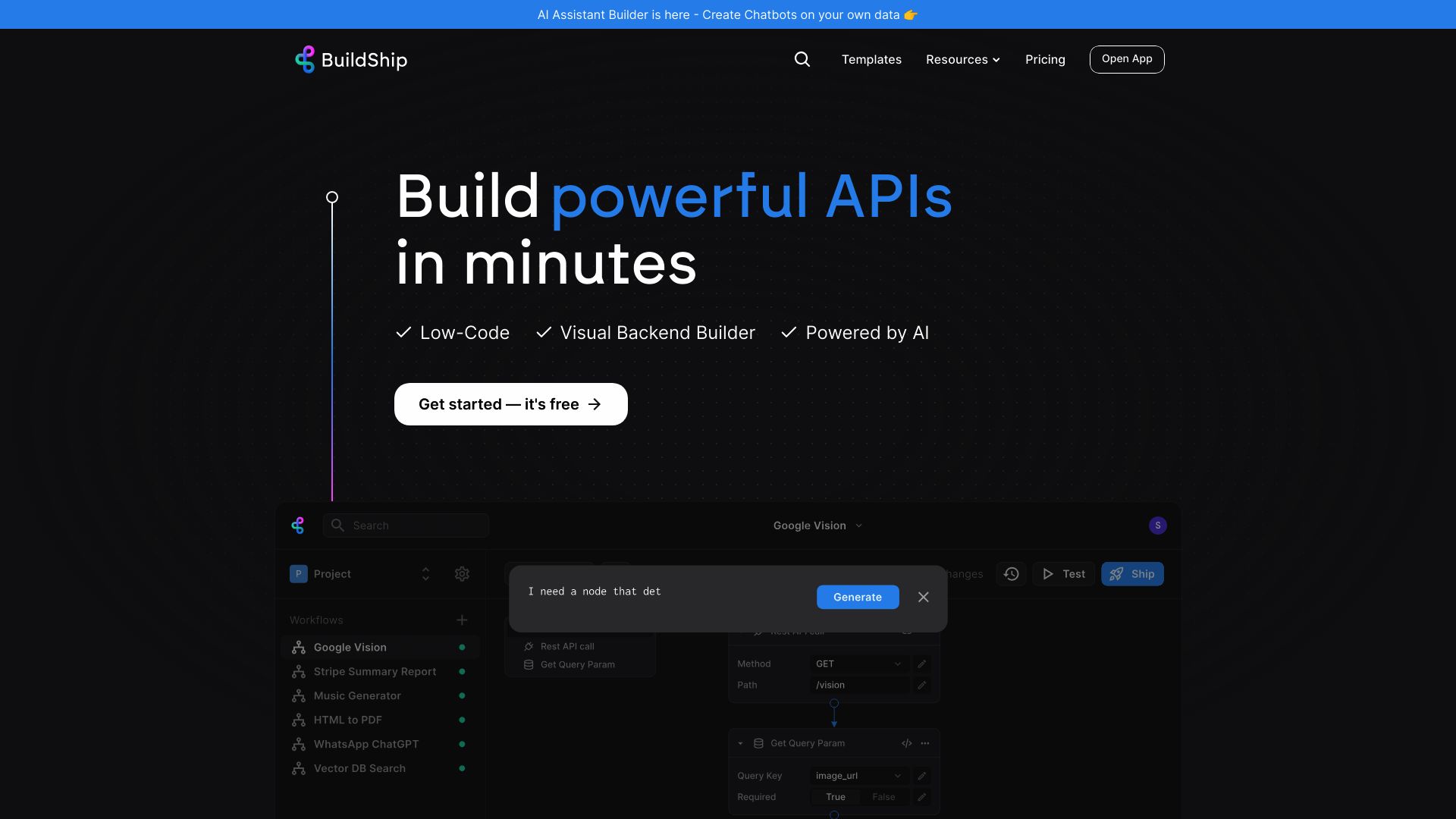AI automation platforms revolutionize how businesses streamline operations and boost productivity. This comparison explores Zapier vs. BuildShip, and SmythOS, three leading solutions in the market. Zapier connects thousands of web applications, enabling simple workflow automation.
BuildShip focuses on backend development, offering AI-assisted workflow creation and comprehensive testing. SmythOS goes further, combining extensive integrations, powerful backend capabilities, and advanced AI agent functionalities. We’ll examine each platform’s strengths, limitations, and ideal use cases to help you choose the best fit for your automation needs.
Zapier Overview
Zapier empowers users to connect and automate workflows across 6000+ web applications without coding. The platform’s visual builder lets anyone create multi-step ’Zaps’ that trigger actions between apps, streamlining repetitive tasks and data flows.

Zapier empowers users to connect and automate workflows across 6000+ web applications without coding.
Zapier’s strength lies in its vast integration library and user-friendly interface. Business users can quickly set up workflows like automatically adding new leads to a CRM or syncing data between project management tools. For developers, Zapier offers a CLI and tools to build custom integrations, expanding the platform’s capabilities.
While Zapier excels at app connectivity, it lacks native AI agent capabilities. The platform doesn’t offer features like conversational AI, machine learning, or autonomous problem-solving. This limitation may impact users seeking more advanced automation beyond simple triggers and actions.
Zapier’s ecosystem includes robust logging, monitoring, and team collaboration features. Users can track Zap performance, troubleshoot issues, and work together on integrations. The platform also prioritizes security, supporting OAuth and various authentication methods to protect sensitive data as it flows between applications.
BuildShip Overview
BuildShip empowers users to create powerful backend workflows and APIs without extensive coding knowledge. This visual no-code platform streamlines the development process, allowing teams to build, test, and deploy solutions faster than traditional methods.
At its core, BuildShip offers a drag-and-drop interface for constructing workflows. Users can leverage pre-built nodes or generate custom ones using AI assistance. The platform integrates seamlessly with various data sources, APIs, and AI models, enabling the creation of complex automations. For those requiring more control, BuildShip allows custom logic implementation in JavaScript or TypeScript.
BuildShip stands out with its comprehensive testing capabilities. Users can validate individual nodes and entire workflows, ensuring reliability before deployment. Once finalized, these workflows transform into production-grade APIs, ready for integration into applications. The platform also supports scheduled executions, enabling automated processes without constant oversight.

Innovative AI features set BuildShip apart from competitors. The AI autofill functionality allows users to populate inputs using natural language prompts, streamlining the development process. A template library accelerates projects by providing starting points for common use cases. Security remains a priority, with BuildShip offering secure storage for API keys and secrets.
BuildShip empowers users to create powerful backend workflows and APIs without extensive coding knowledge. This visual no-code platform streamlines the development process…
While BuildShip excels in many areas, it lacks some advanced features found in dedicated AI agent platforms. It does not offer hosted AI agents, autonomous agents, or multi-agent collaboration. However, for teams focused on workflow automation and API creation, BuildShip provides a robust, user-friendly solution that balances power with accessibility.
Feature Comparison
Zapier and BuildShip offer distinct approaches to workflow automation and API creation. Zapier excels at connecting thousands of web applications through its extensive integration library, allowing users to create multi-step workflows called Zaps. BuildShip, on the other hand, focuses on building powerful backend workflows and APIs with a visual interface.
While both platforms provide visual builders and no-code options, BuildShip offers more advanced features for creating complex backend logic. It supports custom node creation with AI assistance and allows users to implement custom logic in JavaScript or TypeScript. Zapier lacks these capabilities, limiting users to pre-defined actions and basic logic.
BuildShip’s comprehensive testing features surpass Zapier’s offerings. Users can validate individual nodes and entire workflows before deployment, ensuring reliability. Zapier provides basic error handling and testing, but lacks the depth of BuildShip’s testing capabilities. However, Zapier’s strength lies in its vast integration ecosystem, connecting over 6000 apps compared to BuildShip’s more limited selection.
Feature Comparison Table
| Zapier | BuildShip | SmythOS | |
|---|---|---|---|
| CORE FEATURES | |||
| AI Agents | ❌ | ✅ | ✅ |
| Hosted Agents (Dev, Production) | ❌ | ✅ | ✅ |
| Memory & Context | ❌ | ❌ | ✅ |
| Autonomous Agents | ❌ | ❌ | ✅ |
| Explainability & Transparency | ❌ | ❌ | ✅ |
| Multimodal | ❌ | ❌ | ✅ |
| Problem-Solving Capabilities | ❌ | ❌ | ✅ |
| Multi-Agent Collaboration | ❌ | ❌ | ✅ |
| Human-AI Interaction | ❌ | ❌ | ✅ |
| Audit Logs for Analytics | ✅ | ❌ | ✅ |
| Work as Team | ✅ | ❌ | ✅ |
| Agent Work Scheduler | ❌ | ✅ | ✅ |
| SECURITY | |||
| Constrained Alignment | ❌ | ❌ | ✅ |
| IP Control | ❌ | ✅ | ✅ |
| COMPONENTS | |||
| Foundation AIs | ❌ | ❌ | ✅ |
| Huggingface AIs | ❌ | ❌ | ✅ |
| Zapier APIs | ✅ | ❌ | ✅ |
| Classifiers | ❌ | ❌ | ✅ |
| Logic | ❌ | ✅ | ✅ |
| Data Lakes | ❌ | ❌ | ✅ |
| DEPLOYMENT OPTIONS (EMBODIMENTS) | |||
| Staging Domains | ✅ | ❌ | ✅ |
| Production Domains | ✅ | ❌ | ✅ |
| Deploy as Site Chat | ❌ | ❌ | ✅ |
| Deploy as Scheduled Agent | ❌ | ✅ | ✅ |
| Deploy as GPT | ❌ | ❌ | ✅ |
| DATA LAKE SUPPORT | |||
| Hosted Vector Database | ❌ | ❌ | ✅ |
| Sitemap Crawler | ❌ | ❌ | ✅ |
| YouTube Transcript Crawler | ❌ | ❌ | ✅ |
| URL Crawler | ❌ | ❌ | ✅ |
| PDF Support | ❌ | ❌ | ✅ |
| Word File Support | ❌ | ❌ | ✅ |
| TXT File Support | ❌ | ❌ | ✅ |
Best Alternative to Zapier and BuildShip
SmythOS stands out as the superior alternative to Zapier and BuildShip for AI-powered automation and workflow creation. Our platform offers a comprehensive suite of features that surpass the capabilities of both competitors. SmythOS combines the ease of use found in Zapier’s visual interface with the advanced backend logic of BuildShip, while adding powerful AI agent functionality.
Unlike Zapier and BuildShip, SmythOS provides true AI agents with memory, context, and autonomous problem-solving abilities. We enable multi-agent collaboration and human-AI interaction, opening up limitless use cases beyond simple app integrations or backend workflows. Our drag-and-drop interface makes it easy for users of all skill levels to create sophisticated AI solutions without coding.
SmythOS provides true AI agents with memory, context, and autonomous problem-solving abilities… opening up limitless use cases beyond simple app integrations or backend workflows.
SmythOS offers unmatched flexibility in deployment options. Users can host agents in development and production environments, deploy them as APIs, chatbots, scheduled tasks, or even GPT models. This versatility, combined with our extensive integration ecosystem, allows for seamless incorporation of AI into existing business processes.
With SmythOS, organizations gain access to cutting-edge AI capabilities like multimodal interactions, natural language processing, and computer vision — features absent in Zapier and BuildShip. Our platform’s scalability, robust security measures, and comprehensive analytics tools make it ideal for enterprise-level implementations while remaining accessible to smaller teams and individual developers.
We’ve designed SmythOS to unlock the full potential of AI for businesses of all sizes. By choosing our platform, users gain a powerful toolset for creating intelligent, adaptable solutions that drive innovation and efficiency across their organization.
Conclusion
Zapier and BuildShip offer powerful automation solutions, each with distinct strengths. Zapier excels in connecting thousands of web applications, providing a vast integration ecosystem for streamlined workflows. BuildShip focuses on backend development, offering AI-assisted node creation and comprehensive testing capabilities.
While both platforms empower users with no-code options, SmythOS elevates automation to new heights. Our platform combines the best of both worlds, offering extensive integrations like Zapier and powerful backend capabilities like BuildShip, while adding advanced AI agent functionalities. SmythOS’s drag-and-drop interface, support for multiple AI models, and ability to deploy agents across various platforms set it apart in the automation landscape.
SmythOS stands out with its multi-agent collaboration, autonomous problem-solving capabilities, and flexibility in deployment options. Whether you need chatbots, APIs, or scheduled agents, our platform adapts to your specific requirements. Explore our diverse range of AI-powered agent templates to jumpstart your automation journey and see the SmythOS difference for yourself.
Ready to revolutionize your workflow with AI? Create a free SmythOS account and start building unlimited AI agents today. Experience the future of automation with our risk-free trial, offering 10,000 tasks or 30 days to fully explore the platform’s capabilities.